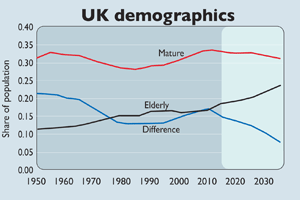A headwind for bonds
A sea change in the age structure of several major economies will have profound implications for markets.

A wide array of factors affect asset prices over the longer term, but demographics are "among the most powerful", says the latest annual Equity Gilt Study from Barclays. That implies that the coming sea change in the age structure of several major economies will have had "potentially profound" implications for markets.
The segment of the population that saves the most into stocks and bonds is the "mature worker", aged around 40-64. Meanwhile, the elderly are more likely to sell their holdings and run down their savings. Since 1980, a steady rise in the proportion of elderly people has been offset by an increase in mature workers worldwide. This has led to a "global savings glut", buoying asset markets.
But now the tide is turning. The study looks at major economies, including Europe, China, Japan and America. The proportion of mature workers is flattening out or declining, and that of elderly spenders is climbing. The upshot is that as the gap between these two categories narrows over the next two decades, "the age structure is projected to become markedly less savings-friendly".
MoneyWeek
Subscribe to MoneyWeek today and get your first six magazine issues absolutely FREE

Sign up to Money Morning
Don't miss the latest investment and personal finances news, market analysis, plus money-saving tips with our free twice-daily newsletter
Don't miss the latest investment and personal finances news, market analysis, plus money-saving tips with our free twice-daily newsletter
Japan has blazed the trail. The savings rate there fell as the working population dwindled in the 1990s. This did not have much impact on Japanese asset prices, which were propped up by savings from the rest of the world. But now that the main developed economies and China are all set for a demographic reversal, the savings glut is set to be soaked up.

The outcome may fall far short of these figures, but even declines of half this size would add up to "a substantial dislocation of the balance between savings and investment".
All this implies a growing long-term headwind for equities. But it constitutes a bigger threat to bonds, which are historically absurdly overpriced, as we noted last week. The link between demographics and asset prices "seems quite inconsistent with market pricing of very low or negative five-year and even ten-year" bonds, as the report puts it.
The ageing population points to lower prices, and higher yields and interest rates, and is therefore another potential pin that could burst the bond bubble.
Get the latest financial news, insights and expert analysis from our award-winning MoneyWeek team, to help you understand what really matters when it comes to your finances.

-
 Why UK investors are backing British stocks in 2026
Why UK investors are backing British stocks in 2026The UK stock market may be lacking fashionable technology shares but investors are keen to buy British next year
-
 UK inflation live: did inflation fall in November?
UK inflation live: did inflation fall in November?The ONS releases inflation data for November tomorrow (17 December). Has inflation continued its downward trend?